Abstract
In erythrocytes the reduction of oxidized hemoglobin (methemoglobin) is dependent upon an electron transport reaction between cytochrome b5 and methemoglobin. These two proteins are believed to form a complex whose bonding is principally determined by complementary charge interactions between acidic groups of cytochrome b5 and basic groups of hemoglobin. In order to refine this model, three surface lysyl hemoglobin variants--namely Hb N Baltimore beta 95 (FG2) Lys leads to Glu, Hb I Toulouse beta 66 (E10) Lys leads to Glu, and Hb I Philadelphia alpha 16 (A14) Lys leads to Glu--have been studied with respect to their reducibility and ability to bind cytochrome b5. In the two former variants, the substituted amino acids are located near the heme crevice; in the third one the substitution lies far from it. Substitutions of lysine for glutamic acid in positions beta 66 and beta 95 perturb the formation of the cytochrome b5--hemoglobin complex and result in a dramatic impairment of the cytochrome b5-mediated reduction, whereas the same mutation in position alpha 16 has no effect. We conclude that the lysine residues in positions beta 66 and beta 95 are directly involved in the binding of cytochrome b5. The three-dimensional structure of hemoglobin suggests that the cytochrome b5-binding domain of hemoglobin is constituted by four lysine residues surrounding the heme crevice in both alpha and beta chains. Similarities with other interacting hemoproteins are discussed.
Full text
PDF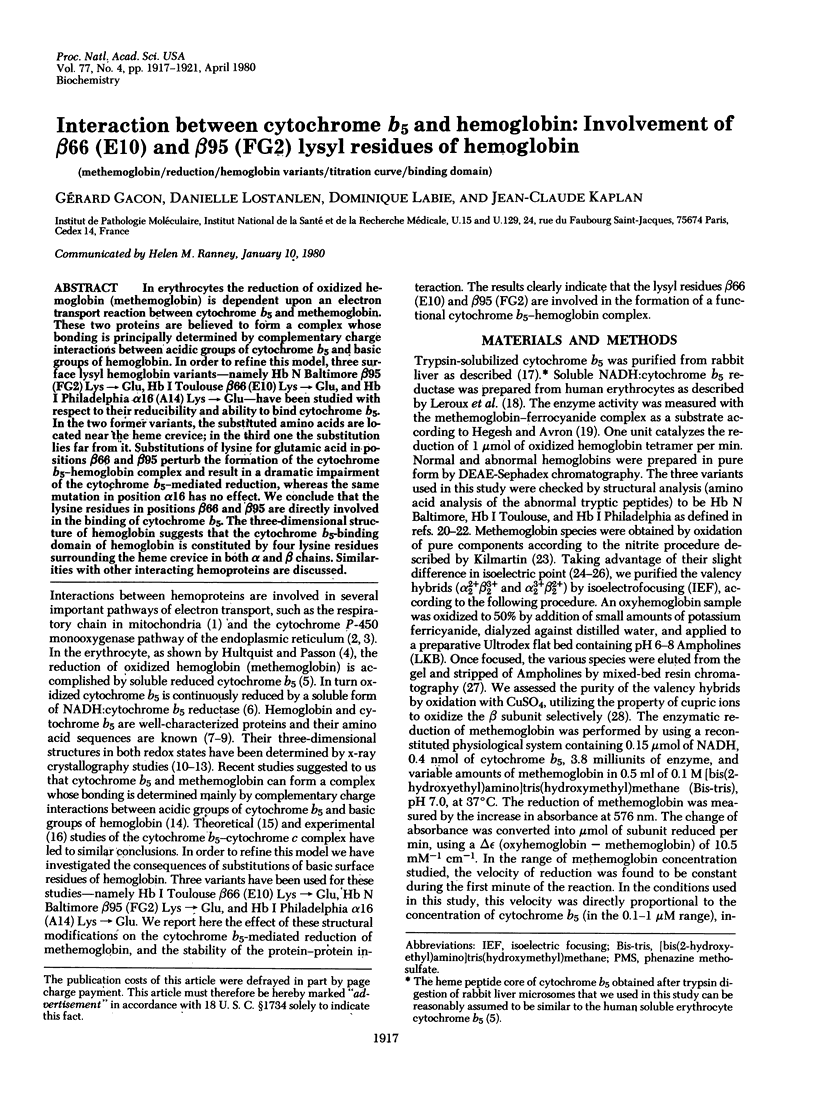
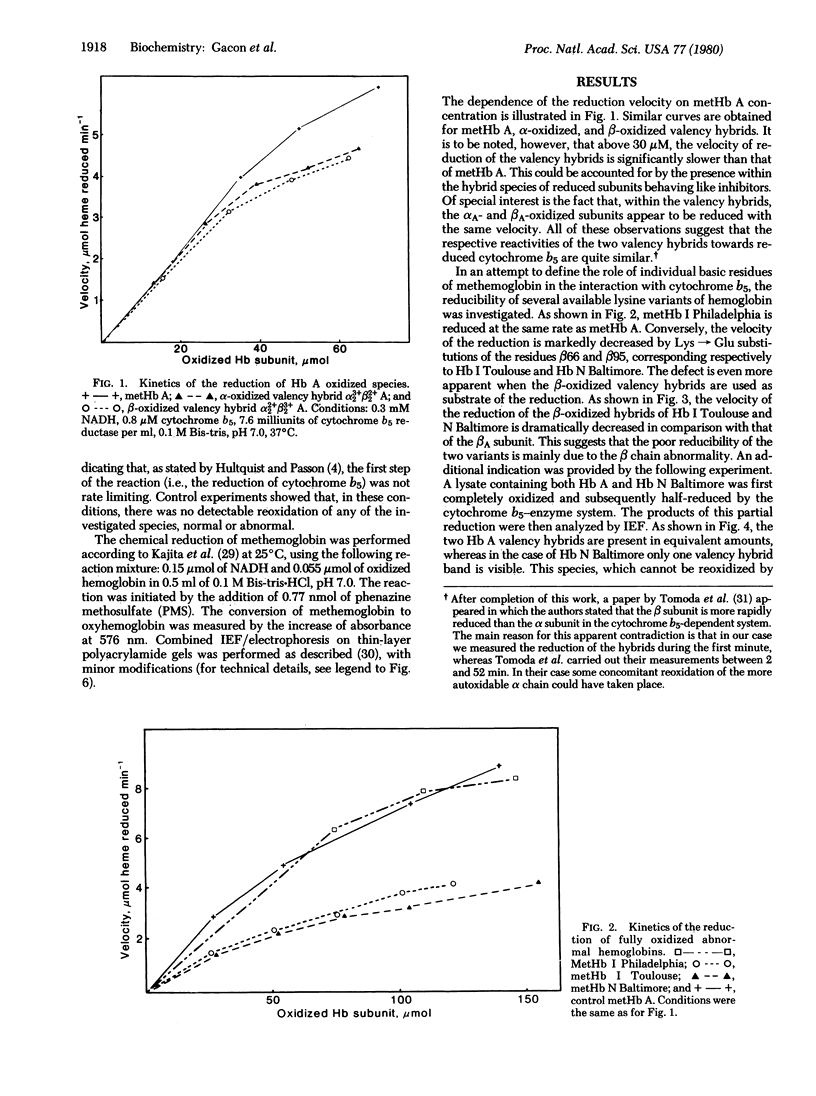
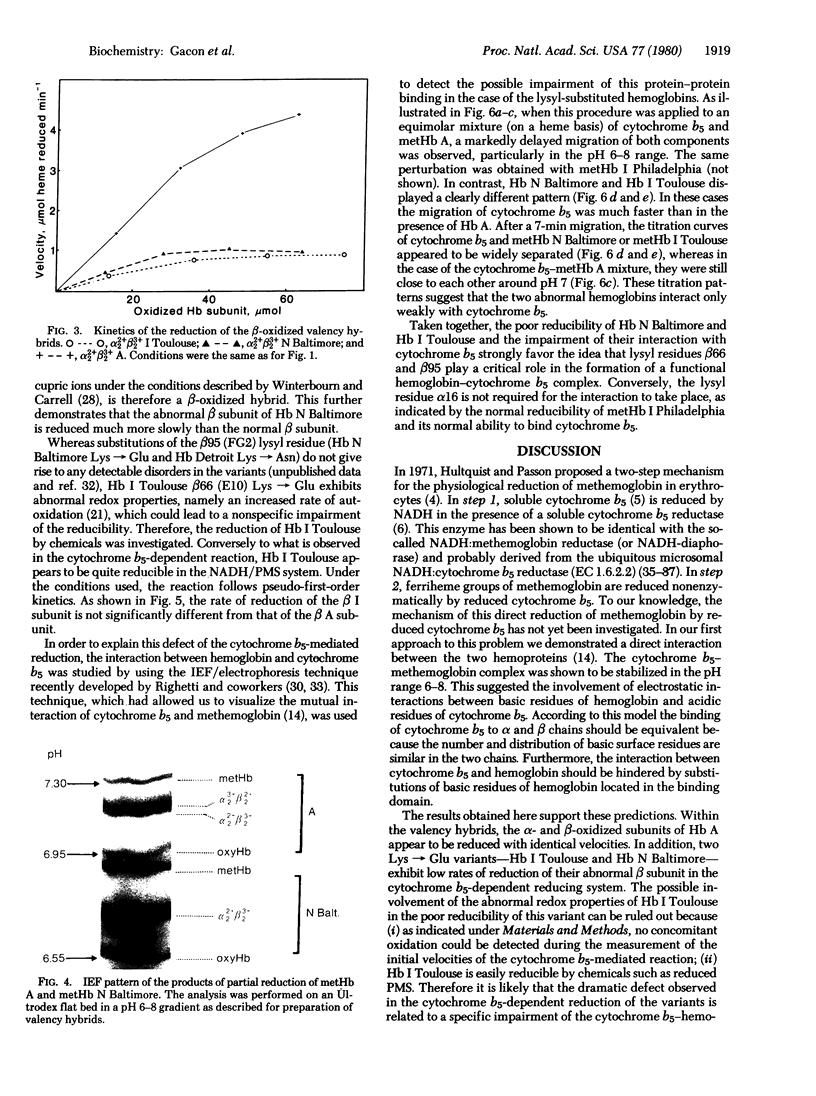
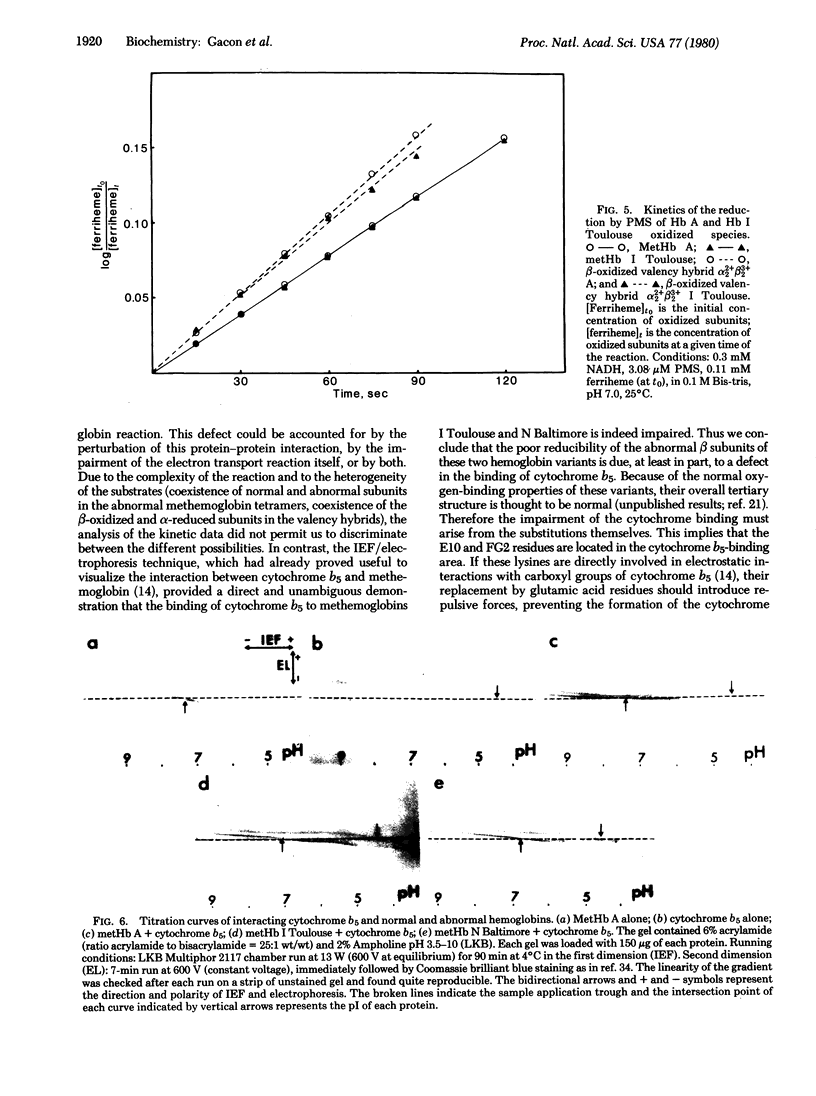
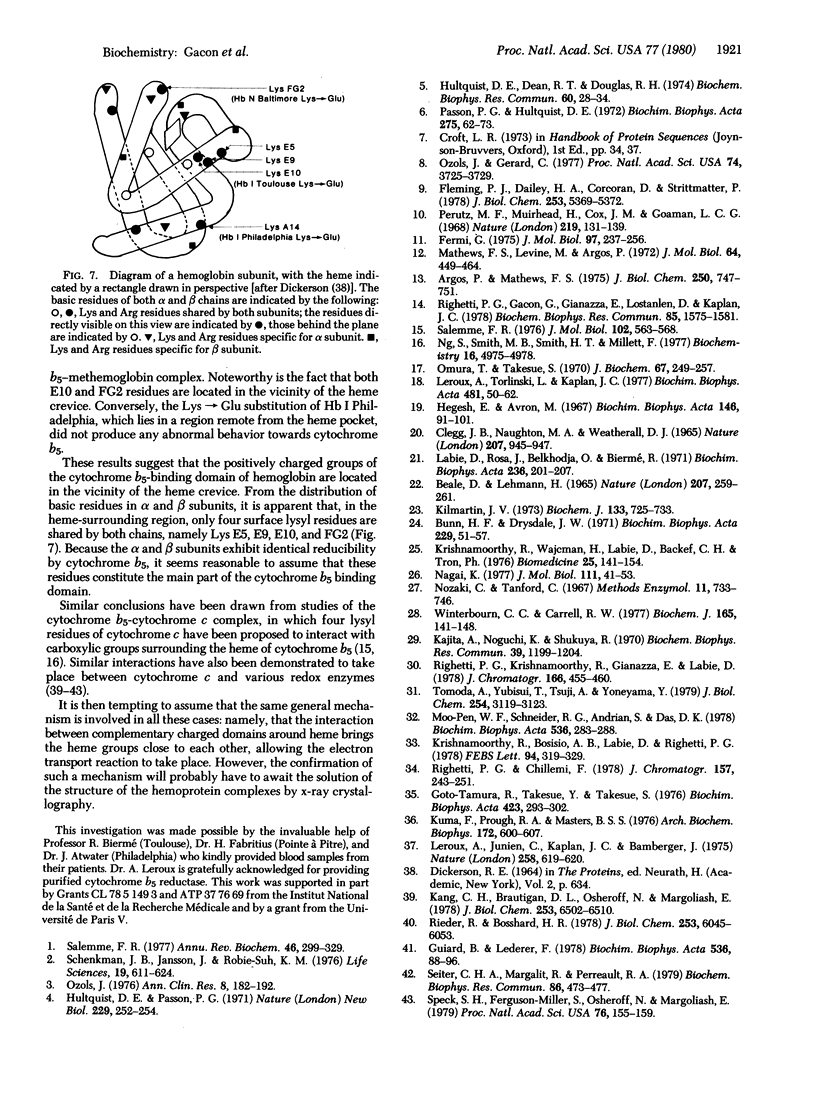
Images in this article
Selected References
These references are in PubMed. This may not be the complete list of references from this article.
- Argos P., Mathews F. S. The structure of ferrocytochrome b5 at 2.8 A resolution. J Biol Chem. 1975 Jan 25;250(2):747–751. [PubMed] [Google Scholar]
- Beale D., Lehmann H. Abnormal haemoglobins and the genetic code. Nature. 1965 Jul 17;207(994):259–261. doi: 10.1038/207259a0. [DOI] [PubMed] [Google Scholar]
- Bunn H. F., Drysdale J. W. The separation of partially oxidized hemoglobins. Biochim Biophys Acta. 1971 Jan 19;229(1):51–57. doi: 10.1016/0005-2795(71)90316-3. [DOI] [PubMed] [Google Scholar]
- Clegg J. B., Naughton M. A., Weatherall D. J. An improved method for the characterization of human haemoglobin mutants: identification of alpha-2-beta-2-95GLU, haemoglobin N (Baltimore). Nature. 1965 Aug 28;207(5000):945–947. doi: 10.1038/207945a0. [DOI] [PubMed] [Google Scholar]
- Fermi G. Three-dimensional fourier synthesis of human deoxyhaemoglobin at 2-5 A resolution: refinement of the atomic model. J Mol Biol. 1975 Sep 15;97(2):237–256. doi: 10.1016/s0022-2836(75)80037-4. [DOI] [PubMed] [Google Scholar]
- Fleming P. J., Dailey H. A., Corcoran D., Strittmatter P. The primary structure of the nonpolar segment of bovine cytochrome b5. J Biol Chem. 1978 Aug 10;253(15):5369–5372. [PubMed] [Google Scholar]
- Goto-Tamura R., Takesue Y., Takesue S. Immunological similarity between NADH-cytochrome b5 reductase of erythrocytes and liver microsomes. Biochim Biophys Acta. 1976 Feb 16;423(2):293–302. doi: 10.1016/0005-2728(76)90186-9. [DOI] [PubMed] [Google Scholar]
- Guiard B., Lederer F. Surface differences and similarities in two homologous proteins. Cytochrome b5 and cytochrome b2 core. Biochim Biophys Acta. 1978 Sep 26;536(1):88–96. doi: 10.1016/0005-2795(78)90054-5. [DOI] [PubMed] [Google Scholar]
- Hegesh E., Avron M. The enzymatic reduction of ferrihemoglobin. I. The reduction of ferrihemoglobin in red blood cells and hemolysates. Biochim Biophys Acta. 1967 Sep 12;146(1):91–101. doi: 10.1016/0005-2744(67)90075-7. [DOI] [PubMed] [Google Scholar]
- Hultquist D. E., Dean R. T., Douglas R. H. Homogeneous cytochrome b5 from human erythrocytes. Biochem Biophys Res Commun. 1974 Sep 9;60(1):28–34. doi: 10.1016/0006-291x(74)90167-3. [DOI] [PubMed] [Google Scholar]
- Hultquist D. E., Passon P. G. Catalysis of methaemoglobin reduction by erythrocyte cytochrome B5 and cytochrome B5 reductase. Nat New Biol. 1971 Feb 24;229(8):252–254. doi: 10.1038/newbio229252a0. [DOI] [PubMed] [Google Scholar]
- Kajita A., Noguchi K., Shukuya R. A simple non-enzymatic method to regenerate oxyhemoglobin from methemoglobin. Biochem Biophys Res Commun. 1970;39(6):1199–1204. doi: 10.1016/0006-291x(70)90688-1. [DOI] [PubMed] [Google Scholar]
- Kang C. H., Brautigan D. L., Osheroff N., Margoliash E. Definitaion of cytochrome c binding domains by chemical modification. Reaction of carboxydinitrophenyl- and trinitrophenyl-cytochromes c with baker's yeast cytochrome c peroxidase. J Biol Chem. 1978 Sep 25;253(18):6502–6510. [PubMed] [Google Scholar]
- Kilmartin J. V. The interaction of inositol hexaphosphate with methaemoglobin. Biochem J. 1973 Aug;133(4):725–733. doi: 10.1042/bj1330725. [DOI] [PMC free article] [PubMed] [Google Scholar]
- Krishnamoorthy R., Bosisio A. B., Righetti P. G. Titration curves of liganded hemoglobins by combined isoelectric focusing-electrophoresis. FEBS Lett. 1978 Oct 15;94(2):319–323. doi: 10.1016/0014-5793(78)80966-1. [DOI] [PubMed] [Google Scholar]
- Krishnamoorthy R., Wajcman H., Labie D., Backef C. H., Tron P. A case of hemoglobin M Boston. New data about valency hybrids brought by isoelectrofocusing study. Biomedicine. 1976 Jun;25(4):151–154. [PubMed] [Google Scholar]
- Kuma F., Prough R. A., Masters B. S. Studies on methemoglobin reductase. Immunochemical similarity of soluble methemoglobin reductase and cytochrome b5 of human erythrocytes with NADH-cytochrome b5 reductase and cytochrome b5 of rat liver microsomes. Arch Biochem Biophys. 1976 Feb;172(2):600–607. doi: 10.1016/0003-9861(76)90113-2. [DOI] [PubMed] [Google Scholar]
- Labie D., Rosa J., Belkhodja O., Bierme R. Hemoglobin toulouse alpha 2 beta 2 66 (E 10) LysGlu. Structure and consequences in molecular pathology. Biochim Biophys Acta. 1971 Apr 27;236(1):201–207. [PubMed] [Google Scholar]
- Leroux A., Junien C., Kaplan J., Bamberger J. Generalised deficiency of cytochrome b5 reductase in congenital methaemoglobinaemia with mental retardation. Nature. 1975 Dec 18;258(5536):619–620. doi: 10.1038/258619a0. [DOI] [PubMed] [Google Scholar]
- Leroux A., Torlinski L., Kaplan J. C. Soluble and microsomal forms of NADH-cytochrome beta 5 reductase from human placenta. Similarity with NADH-methemoglobin reductase from human erythrocytes. Biochim Biophys Acta. 1977 Mar 15;481(1):50–62. doi: 10.1016/0005-2744(77)90136-x. [DOI] [PubMed] [Google Scholar]
- Mathews F. S., Levine M., Argos P. Three-dimensional Fourier synthesis of calf liver cytochrome b 5 at 2-8 A resolution. J Mol Biol. 1972 Mar 14;64(2):449–464. doi: 10.1016/0022-2836(72)90510-4. [DOI] [PubMed] [Google Scholar]
- Moo-Penn W. F., Schneider R. G., Andrian S., Das D. K. Hemoglobin Detroit: beta95 (FG2) lysine leads to asparagine. Biochim Biophys Acta. 1978 Sep 26;536(1):283–288. doi: 10.1016/0005-2795(78)90075-2. [DOI] [PubMed] [Google Scholar]
- Nagai K. The effect of ferric ligands on the oxygen affinity of the ferrous subunits in valency hybrid haemoglobins. J Mol Biol. 1977 Mar 25;111(1):41–53. doi: 10.1016/s0022-2836(77)80130-7. [DOI] [PubMed] [Google Scholar]
- Ng S., Smith M. B., Smith H. T., Millett F. Effect of modification of individual cytochrome c lysines on the reaction with cytochrome b5. Biochemistry. 1977 Nov 15;16(23):4975–4978. doi: 10.1021/bi00642a006. [DOI] [PubMed] [Google Scholar]
- Omura T., Takesue S. A new method for simultaneous purification of cytochrome b5 and NADPH-cytochrome c reductase from rat liver microsomes. J Biochem. 1970 Feb;67(2):249–257. doi: 10.1093/oxfordjournals.jbchem.a129248. [DOI] [PubMed] [Google Scholar]
- Ozols J., Gerard C. Primary structure of the membranous segment of cytochrome b5. Proc Natl Acad Sci U S A. 1977 Sep;74(9):3725–3729. doi: 10.1073/pnas.74.9.3725. [DOI] [PMC free article] [PubMed] [Google Scholar]
- Ozols J. The role of microsomal cytochrome b5 in the metabolism of ethanol, drugs and the desaturation of fatty acids. Ann Clin Res. 1976;8 (Suppl 17):182–192. [PubMed] [Google Scholar]
- Passon P. G., Hultquist D. E. Soluble cytochrome b 5 reductase from human erythrocytes. Biochim Biophys Acta. 1972 Jul 12;275(1):62–73. doi: 10.1016/0005-2728(72)90024-2. [DOI] [PubMed] [Google Scholar]
- Perutz M. F., Muirhead H., Cox J. M., Goaman L. C. Three-dimensional Fourier synthesis of horse oxyhaemoglobin at 2.8 A resolution: the atomic model. Nature. 1968 Jul 13;219(5150):131–139. doi: 10.1038/219131a0. [DOI] [PubMed] [Google Scholar]
- Rieder R., Bosshard H. R. The cytochrome c oxidase binding site on cytochrome c. Differential chemical modification of lysine residues in free and oxidase-bound cytochrome c. J Biol Chem. 1978 Sep 10;253(17):6045–6053. [PubMed] [Google Scholar]
- Righetti P. G., Gacon G., Gianazza E., Lostanlen D., Kaplan J. C. Titration curves of interacting cytochrome b5 and hemoglobin by isoelectric focusing-electrophoresis. Biochem Biophys Res Commun. 1978 Dec 29;85(4):1575–1581. doi: 10.1016/0006-291x(78)91182-8. [DOI] [PubMed] [Google Scholar]
- Salemme F. R. An hypothetical structure for an intermolecular electron transfer complex of cytochromes c and b5. J Mol Biol. 1976 Apr 15;102(3):563–568. doi: 10.1016/0022-2836(76)90334-x. [DOI] [PubMed] [Google Scholar]
- Salemme F. R. Structure and function of cytochromes c. Annu Rev Biochem. 1977;46:299–329. doi: 10.1146/annurev.bi.46.070177.001503. [DOI] [PubMed] [Google Scholar]
- Schenkman J. B., Jansson I., Robie-Suh K. M. The many roles of cytochrome b-5 in hepatic microsomes. Life Sci. 1976 Sep 1;19(5):611–623. doi: 10.1016/0024-3205(76)90156-9. [DOI] [PubMed] [Google Scholar]
- Seiter C. H., Margalit R., Perreault R. A. The cytochrome c binding site on cytochrome c oxidase. Biochem Biophys Res Commun. 1979 Feb 14;86(3):473–477. doi: 10.1016/0006-291x(79)91738-8. [DOI] [PubMed] [Google Scholar]
- Speck S. H., Ferguson-Miller S., Osheroff N., Margoliash E. Definition of cytochrome c binding domains by chemical modification: kinetics of reaction with beef mitochondrial reductase and functional organization of the respiratory chain. Proc Natl Acad Sci U S A. 1979 Jan;76(1):155–159. doi: 10.1073/pnas.76.1.155. [DOI] [PMC free article] [PubMed] [Google Scholar]
- Tomoda A., Yubisui T., Tsuji A., Yoneyama Y. Kinetic studies on methemoglobin reduction by human red cell NADH cytochrome b5 reductase. J Biol Chem. 1979 Apr 25;254(8):3119–3123. [PubMed] [Google Scholar]
- Winterbourn C. C., Carrell R. W. Oxidation of human haemoglobin by copper. Mechanism and suggested role of the thiol group of residue beta-93. Biochem J. 1977 Jul 1;165(1):141–148. doi: 10.1042/bj1650141. [DOI] [PMC free article] [PubMed] [Google Scholar]




